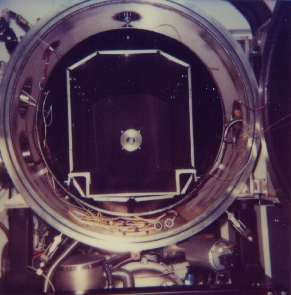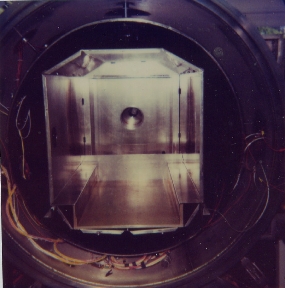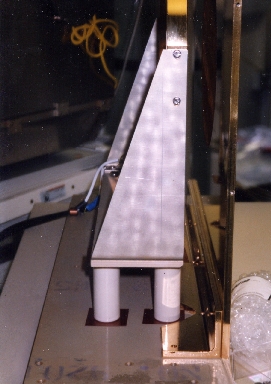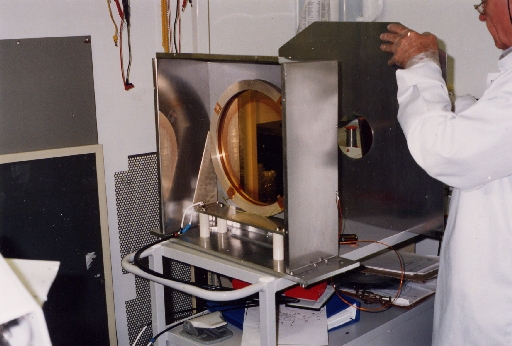
Mu-metal shield in the Leybold chamber

Front view of the mu-metal shield

The electron gun

Another view of the electron gun
The Leybold vacuum chamber was bought in 1991 so that the very intensive
combined vacuum testing expected to be needed for the Cluster mission could
be carried out in MSSL, rather than having to take instruments, support
equipment and personnel elsewhere over many months. On the other hand,
it also appears that there was NO facility available elsewhere to attempt
calibrations over the energy range from some 30 eV to several 10s of keV for
the number of instruments we had to build.
The combined vacuum testing programme would consist of:
1) Establishing the scientific performance
2) Calibration using an electron gun
3) Thermal Vacuum (TV) testing
This combined testing approach of course meant that, with one chamber
for all tasks, any delay in calibration would immediately carry forward
and impose on the TV test schedule, and naturally any TV anomaly, either
of instrument or facility, would impact on the scientific programme.
Naturally all tests required the same cleanliness levels because of using
Micro-Channel Plates (MCP) as detectors, but different approaches and
attitudes were required to implement the idea of 30 kV supplies for the
calibration electron gun.
The MSSL Plasma Electron and Current Experiment (PEACE) instrument (there are four of these, one on each of the four Cluster spacecraft) comprises two sensors (Low Energy Electron Analyser, LEEA, and High Energy Electron Analyser, HEEA) and a Data Processing Unit (DPU). After the sad demise of the original Cluster mission (due to the failure of the first Ariane 5 rocket launch in June 1996), and ESA's decision to re-launch (this time two spacecraft at the time, on Russian SOYUZ/FREGAT rockets in 2000), the MSSL Leybold chamber was again used for many months to test the newly built Cluster 2 PEACE instruments.
For the original Cluster programme (and then again for Cluster 2) we had to
consider that scientific performance testing and calibration would be
carried out on:
i) A development model (not flight standard)
ii) An engineering model
iii) Ten flight models, including Flight Spares
Engineering testing, namely TV tests, would be made on:
a) Engineering Model
b) Four Flight Models
c) Flight Spare
Cluster PEACE, though, was not the only experiment to see the inner walls of the Leybold chamber. Over the period 1991 - 2003 as many as 12 MSSL (and MSSL-associated) experiments were tested in it. In fact, more recently the main activities carried out with the chamber have been calibrations of space plasma experiments.
Below is a list the Flight Programmes (with instrument names in brackets)
that have used the chamber up to approx. 2003:
Cluster 1 and 2 (PEACE) - Calibration and Thermal Vacuum
SOHO (CDS) - Thermal Vacuum
Mars 94/96 (FONEMA) - Thermal Vacuum
Cassini (ELS) - Calibration and Thermal Vacuum
XMM (RGS) - Thermal Vacuum
XMM (OM) - Thermal Vacuum
RESIK - Thermal Vacuum
Mars Express (ASPERA) - Calibration
Venus Express (ASPERA) - Calibration
SWIFT (UVOT) - Thermal Vacuum
Solar-B (EIS) - Thermal Vacuum